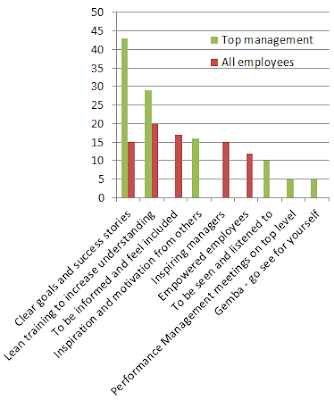What happens otherwise is that the organisation initially get some good results, for example lead time, efficiency, cost and sometimes quality improvements. But the changes do not stick and the organisation never becomes flexible and able to adapt to changes. After some time things go back to the way it was before, the effects erodes and improvements stops. When this happens it can be very hard to "re-launch" a Lean initiative since employees associate it with something negative.
So, what can be done to avoid this pitfall? The question we asked was:
What are critical success factors to get engaged and committed employees who takes responsability and continuously strive to improve?
We were also curious to understand if there is a difference how to get engagement from top management and from associates and therefor asked the question twice for these groups.
- For all employees, managers and associates, it is critical to get a success story to communicate internally. For top management a success story might be achieving tough goals regarding improvements in operational efficiency leading to cost savings or improved customer service for example. For the associates the same success story might be that the operational improvements were achieved while reducing over time, stress and firefighting activities.
- Another critical activity is to train employees on all levels to increase the understanding of Lean. This training can be done internally or externally and should be customized to the organisation and the groups of employees depending on their needs.
- Lean coordinators (Navigators) require the most advanced training since they will coach line managers and often become the future leaders.
- Managers and key resources who are about to get started require some technical skills coupled with leadership training to understand how their leadership need to change.
- All employees need some basic introduction to Lean to understand how the values, principles, ways of working and expected results are related. - Both managers and other employees need inspiration. For management this can be external speakers, consultants or peers from other companies. The managers in turn, need to inspire their associates and be able to explain why the new way of working is important.
- It is absolutely essential for managers to communicate effectively and to make their teams and associates feel informed about and included in the Lean journey.
- The employees have to feel empowered and responsible for their own work and continuous improvement. In order to achieve this managers have to ask questions instead of telling the employees what to do.
- The managers need to be present on the floor and go and see for themselves. They need to transform from managers who read reports and administer to leaders who coach and see all their associates and help them to grow.


